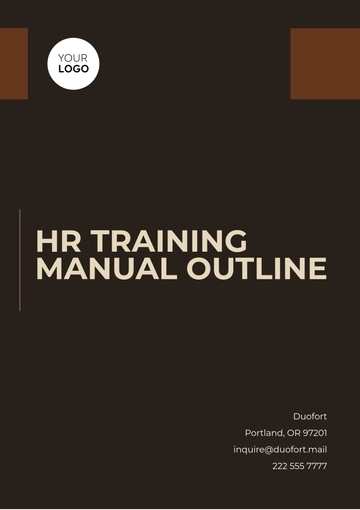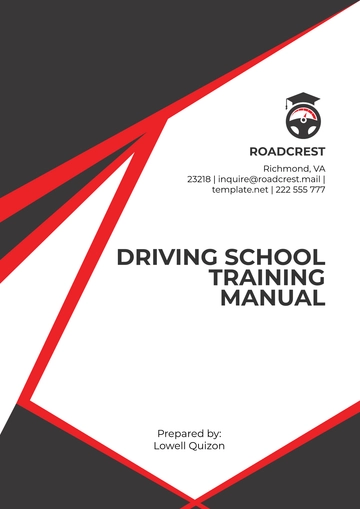Free Product Manager Training Manual

Name | [YOUR NAME] |
|---|---|
Company | [YOUR COMPANY NAME] |
Department | [YOUR DEPARTMENT] |
Date | [DATE] |
I. Introduction
Welcome to the [YOUR COMPANY NAME] Product Manager Training Manual. This comprehensive guide is designed to equip aspiring and current product managers with the knowledge, skills, and tools necessary to excel in their roles. Whether you're new to product management or seeking to enhance your expertise, this manual serves as your roadmap to success. Throughout this training, you will explore key concepts, methodologies, and best practices that are essential for effective product management.
In this section, we'll provide an overview of the manual's structure and how to make the most of its contents. [YOUR NAME], as the author of this manual, has drawn upon years of experience in product management to create a resource that is both informative and practical. Whether you're a self-learner, part of a corporate training program, or an educator, you'll find valuable insights and actionable steps to elevate your product management skills.
II. Getting Started
A. About the Author
[YOUR NAME] is a seasoned product manager with over a decade of experience in the tech industry. Throughout [YOUR DEPARTMENT], they have led cross-functional teams to successfully launch innovative products and drive business growth. [YOUR NAME] is passionate about sharing their knowledge and helping others succeed in the dynamic field of product management.
B. About [YOUR COMPANY NAME]
[YOUR COMPANY NAME] is a leading provider of [Brief description of the company]. As a pioneer in the industry, we prioritize innovation and customer satisfaction. Our team is committed to developing top-notch products that address market needs and exceed user expectations.
C. Manual Objectives
Provide a comprehensive understanding of product management principles.
Equip learners with practical tools and techniques for effective product management.
Foster a community of learners and practitioners to share insights and best practices.
III. Fundamentals of Product Management
A. Definition and Scope
Product management encompasses the end-to-end process of developing and delivering a product to market. It involves identifying market opportunities, defining product requirements, and overseeing the product lifecycle. [YOUR COMPANY NAME] recognizes the importance of product management in driving business success and achieving strategic objectives.
B. Key Responsibilities
As a product manager, you will be responsible for various tasks, including:
Conducting market research to identify customer needs and market trends.
Defining product vision and strategy to align with business goals.
Collaborating with cross-functional teams to prioritize features and deliver value to customers.
Analyzing product performance and iterating based on user feedback.
C. Essential Skills
Successful product managers possess a diverse set of skills, including:
Strategic Thinking: Ability to align product goals with overall business objectives.
Communication: Effective communication with stakeholders, team members, and customers.
Problem-Solving: Proactively identifying and addressing challenges throughout the product lifecycle.
Data Analysis: Utilizing data-driven insights to make informed decisions and drive product improvements.
IV. Product Development Process
A. Stage 1: Ideation and Conceptualization
This stage involves generating ideas and concepts for new products or enhancements to existing products. Key activities include:
Conducting brainstorming sessions to generate innovative ideas.
Evaluating market demand and competitive landscape.
Defining the initial concept and value proposition for the product.
B. Stage 2: Requirements Gathering and Prioritization
Once the concept is established, the next step is to gather requirements and prioritize features. This stage includes:
Engaging with stakeholders to understand their needs and requirements.
Creating user stories and defining product features.
Prioritizing features based on factors such as market demand, technical feasibility, and business value.
C. Stage 3: Development and Testing
In this stage, the product is developed and tested to ensure it meets quality standards and user expectations. Key activities include:
Collaborating with engineering teams to build and release product increments.
Conducting user testing and gathering feedback for iterative improvements.
Monitoring progress and addressing any issues or roadblocks that arise during development.
V. Product Lifecycle Management
A. Introduction to Product Lifecycle
Understanding the product lifecycle is crucial for effective product management. This section provides an overview of the stages of a product's lifecycle and the key considerations at each stage.
B. Stages of Product Lifecycle
The product lifecycle typically consists of the following stages:
Introduction: The product is launched into the market, and sales begin to grow slowly as awareness spreads.
Growth: Sales accelerate as the product gains traction, and market acceptance increases.
Maturity: Sales peak, and competition intensifies as the market becomes saturated with similar products.
Decline: Sales decline as customer preferences shift or new technologies emerge.
C. Strategies for Each Lifecycle Stage
Throughout each stage of the product lifecycle, product managers employ different strategies to maximize success:
Introduction: Focus on building awareness and gaining initial customer adoption.
Growth: Invest in scaling operations and expanding market reach.
Maturity: Differentiate the product and explore new market segments to maintain sales.
Decline: Evaluate options such as product diversification, rebranding, or discontinuation.
VI. Market Analysis and Competitive Intelligence
A. Market Research Techniques
Effective market analysis begins with thorough research. This section explores various techniques for gathering market data and insights:
Surveys and Questionnaires: Collect feedback from target customers to understand their needs and preferences.
Competitor Analysis: Analyze competitors' products, pricing strategies, and market positioning to identify opportunities and threats.
Trend Analysis: Monitor industry trends, technological advancements, and consumer behavior to anticipate market shifts.
B. SWOT Analysis
SWOT (Strengths, Weaknesses, Opportunities, Threats) analysis is a valuable tool for assessing the internal and external factors affecting a product or business. This section outlines the process of conducting a SWOT analysis and provides a template for organizing findings.
C. Competitive Intelligence
Gathering competitive intelligence involves researching and analyzing competitors' strategies, products, and market positioning. Product managers use this information to inform their own product strategy and identify areas for differentiation.
VII. Stakeholder Management
A. Identifying Stakeholders
Stakeholders are individuals or groups with an interest or influence in the product's success. This section discusses how to identify and categorize stakeholders, including internal teams, customers, partners, and executives.
B. Stakeholder Engagement Strategies
Effective stakeholder management involves engaging with stakeholders throughout the product lifecycle. This section explores strategies for building strong relationships with stakeholders, including regular communication, soliciting feedback, and addressing concerns proactively.
C. Conflict Resolution
Conflicts may arise among stakeholders due to competing priorities or differing opinions. Product managers must be skilled at resolving conflicts and fostering collaboration. This section provides techniques for managing conflicts and reaching mutually beneficial resolutions.
VIII. Resources and Tools
A. Recommended Reading
To further your understanding of product management principles and practices, we recommend the following books:
"Inspired: How to Create Products Customers Love" by Marty Cagan
"The Lean Startup: How Today's Entrepreneurs Use Continuous Innovation to Create Radically Successful Businesses" by Eric Ries
"Hooked: How to Build Habit-Forming Products" by Nir Eyal
B. Online Courses and Training Programs
Expand your skills and knowledge through online courses and training programs offered by reputable institutions and platforms such as:
Product Management Certificate Program by Product School
Agile Product Management by Coursera
Product Management Fundamentals by Udemy
C. Tools and Software
Discover tools and software that can streamline your product management processes, including:
Product roadmap software such as Aha! and Product board
Collaboration tools like Slack and Microsoft Teams
Customer feedback platforms such as User Voice and Zendesk
IX. Conclusion
Congratulations on completing the [YOUR COMPANY NAME] Product Manager Training Manual! We hope this comprehensive resource has provided you with valuable insights and practical guidance for navigating the exciting world of product management. Remember, success in product management requires continuous learning, adaptability, and a passion for innovation. Stay curious, keep honing your skills, and never stop striving for excellence.
For ongoing support and resources, be sure to connect with our community of product management professionals and stay updated on industry trends and best practices. Thank you for choosing [YOUR COMPANY NAME] as your partner in professional development.
- 100% Customizable, free editor
- Access 1 Million+ Templates, photo’s & graphics
- Download or share as a template
- Click and replace photos, graphics, text, backgrounds
- Resize, crop, AI write & more
- Access advanced editor
Introducing the Product Manager Training Manual Template from Template.net! Elevate your team's skills with this editable and customizable resource. Crafted for efficiency, it's easily tailored to your company's needs. Seamlessly edit in our Ai Editor Tool, ensuring precision and ease. Streamline your training process today!





























